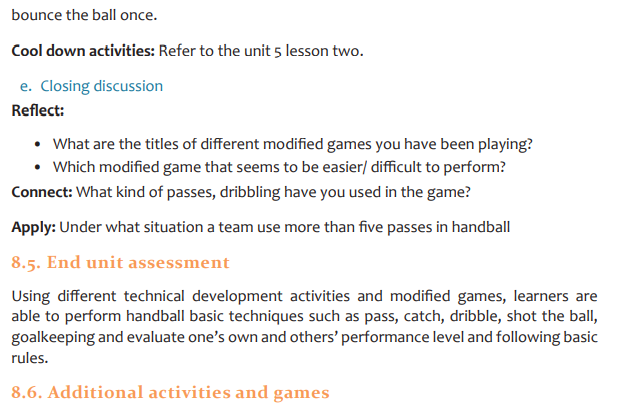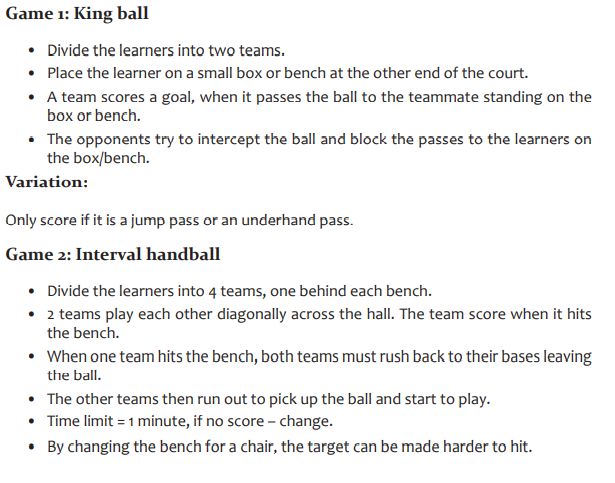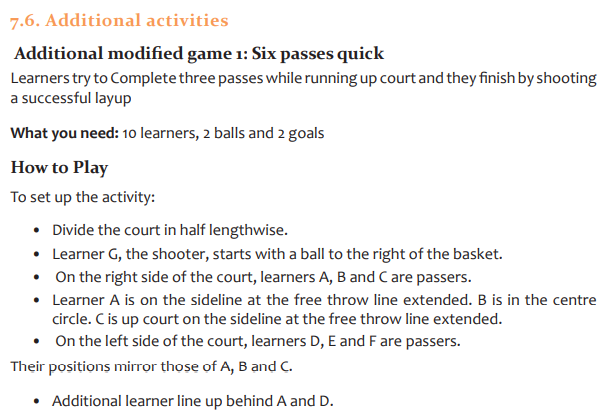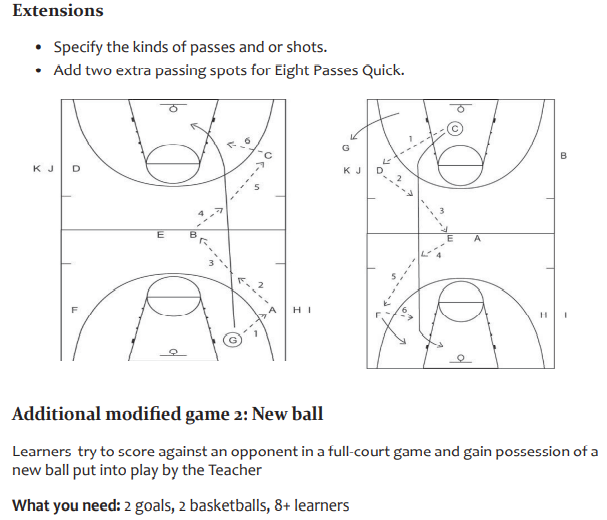Topic outline
General
General
PART I. GENERAL INTRODUCTION
I.0. About the teacher’s guide
This book is a teacher’s guide for Physical Education and Sports for P4. It is designed to help teachers in the implementation of competence based curriculum.
As the name says, it is a guide that teachers can refer to when preparing their lessons. Teachers may prefer to adopt provided activities/games/exercises and related guidance but they are also expected to be more creative and consider their specific classes’ contexts and prepare accordingly.
I.1. The structure of the guide
This section presents the overall structure of this guide, the unit and lesson structure to help teachers to understand the different sections of this guide and what they will find in each section.
Overall structure
The whole guide has three main parts as follows:
Part I: General Introduction
This part provides general guidance on how to develop the generic competences, how to integrate cross cutting issues, how to cater for learners with special educational needs, active methods and techniques of teaching Physical Education and Sports and guidance on assessment
Part II: Sample lesson plan
This part provides a sample lesson plan, developed and designed to help the teacher developing their own lesson plans.
Part III: Unit development
This is the core part of the guide. Each unit is developed following the structure as prescribed in subtitle structure of a unit This teachers’ guide has some changes considering pre-established number of periods allocated for each unit in the syllabus.
The following changes upon periods allocated to each unit were made:
- Unit 1 (Motor control) changed from 4 to 3 periods.
- Unit 3 (Gymnastics) changed from 2 periods to 3 periods.
- Unit 5 (Football) changed from 5 periods to 4 periods.
- Unit 9 (Transmitted diseases) changed from 1 period to 3 periods.
Structure of a unit
Each unit is made of the following sections:
Unit title: From the syllabus
Key unit competence: From the syllabus
Prerequisites (knowledge, skills, attitudes and values
This section indicates knowledge, skills and attitudes required for the success of the unit. The competence-based approach calls for connections between units/topics within a subject and interconnections between different subjects. The teacher will find an indication of those prerequisites and guidance on how to establish connections.
UNIT 1: MOTOR CONTROL
1.1.Key unit competence:
Learners will learn better this lesson if they are able to perform a range of aerobic
1.2 Prerequisite knowledge and skill
Learners will learn better this unit if they are able to perform physical activities like
running, jumping, etc
1.3 Cross-cutting issues to be addressed
• Peace and values education: Encourage teamwork spirit, mutual help, and
respect of opinions of colleagues among learners.
• Gender education: Engage both girls and boys and help them to exploit their full
potentials: No activity is reserved only for girls or boys.
• Inclusive education: Identify the learners with special education needs, ensure
interactive and inclusive discussion
• Financial education: Facilitate/guide learners to make non cost materials like report from banana leaves fibers1.4 List of lessons
a. Prerequisite
a learner is able to perform different physical exercises needed to carry out different
aerobic warm up exercises
b. Teaching resources: Playground, whistles, stops watches etc
c. Introduction
Opening discussions( in playground)
• Check sports uniform;
• Set simple ground rules with learners to create a safe atmosphere;
• Choose a system/formation which matches with the type of activity, for opening
discussion; motivation and curiosity of learners and prepare them to learn;
• Ensure interactive and inclusive discussion;• Acknowledge each learner’s contribution.
͜
Quizzes: 4Labels: 22Files: 2UNIT 8: HANDBALL
8.1 Key unit competence














































UNIT 9: TRANSMITTED DISEASES
9.1. Key unit competence
































































